Circulatory System
- Books Name
- CBSE Class 7 Science Book
- Publication
- Param Publication
- Course
- CBSE Class 7
- Subject
- Science
CIRCULATORY SYSTEM OF HUMAN BEING
• Circulatory system consists of blood, blood vessels and heart.
BLOOD : Blood has following components -
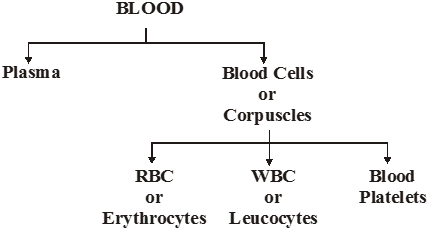
• Blood is a liquid, which has cells of various kinds suspended in it. The fluid part of the blood is called plasma.
• One type of cells are the red blood cells (RBC) which contain a red pigment called haemoglobin. Haemoglobin binds with oxygen and transports it to all the parts of the body and ultimately to all the cells. It will be difficult to provide oxygen efficiently to all the cells of the body without haemoglobin. The presence of haemoglobin makes blood appear red.
• The blood also has white blood cells (WBC) which fights against germs that may enter our body. Another type of cells in the blood are called as platelets, which helps in the clotting of blood.
Function of Blood
• Blood is the fluid connective tissue, which flows in blood vessels.
• It transports substances like digested food from the small intestine to the other parts of the body.
• It carries oxygen from the lungs to the cells of the body.
• It also transports waste for removal from the body.
• It maintains equal temperature throughout of the body.
Blood vessels
In body three types of blood vessels are present. These are arteries, veins and capillaries.
• Arteries carry oxygen-rich blood from the heart to all parts of the body except pulmonary artery. Since the blood flow is rapid and at a high pressure, the arteries have thick, elastic walls.
• Veins are the vessels, which carry carbon dioxide rich blood from all parts of the body back to the heart except pulmonary vein. The veins have thin walls.
• There are valves present in veins which allow blood to flow only towards the heart or prevent backward flow of blood.
• The arteries divide into smaller vessels. On reaching the tissues, they divide further into extremely thin tubes called capillaries. The capillaries join up to form veins, which empty into the heart.
Excretion in Animals
- Books Name
- CBSE Class 7 Science Book
- Publication
- Param Publication
- Course
- CBSE Class 7
- Subject
- Science
EXCRETION IN ANIMALS
• When our cells perform their functions, certain waste products are released. These are toxic and hence need to be removed from the body. The process of removal of wastes produced in the cells of the living organisms is called excretion. The parts involved in excretion forms the excretory system.
• The way in which waste chemicals are removed from the body of the animal depends on the availability of water. Aquatic animals like fishes, excrete cell waste in gaseous form (ammonia) which is directly dissolved in water so called Ammonotelic.
• Some land animals like birds, lizards, snakes excrete a semi-solid, white coloured compound (uric acid) so called Uricotelic.
• The major excretory product in humans is urea so called Ureotelic.
Excretory System in Humans
Excretory system in humans consists of the following organs.
• A pair of kidneys
• Ureters
• Urinary bladder
• Urethra
Kidneys are bean-shaped structures located just above the waist. Each kidney consists of a large number of coiled tubes called nephrons. They act as filters and filter waste products from the blood which reach the two kidneys. The useful substances are absorbed back into the blood.
Waste products dissolved in water form the liquid urine. The urine contains 95% water, 2.5% urea and 2.5% other waste products.
A narrow tube called ureter runs from the inner side of each kidney. The two ureters from the two kidneys are connected to a large sac called bladder. Urine passes out from the kidney through the two ureters into the urinary bladder. It is stored in the urinary bladder. From the bladder, urine passes through another muscular tube called the urethra and is finally passed out through a urinary opening at the end of the urethra.
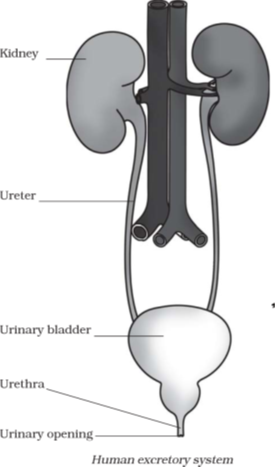
Other Organs of Excretion in Humans
1. Lungs: They remove carbon dioxide and water produced during respiration.
2. Skin: It removes urea, salt and excess water through sweat glands present in the skin.
3. Large intestine: The large intestine removes solid wastes.
4. Liver: It removes excess sugar by converting it into glycogen.
• Sometimes a person’s kidneys may stop working due to infection or injury. As a result of kidney failure, waste products start accumulating in the blood. Such persons cannot survive unless their blood is filtered periodically through an artificial kidney. This process is called dialysis.
• The sweat in human beings contain water and salts, which is also regarded as dilute wine. Sweat helps in keeping our body cool, besides removing waste materials.
Excretion in Animals
Excretion in animals
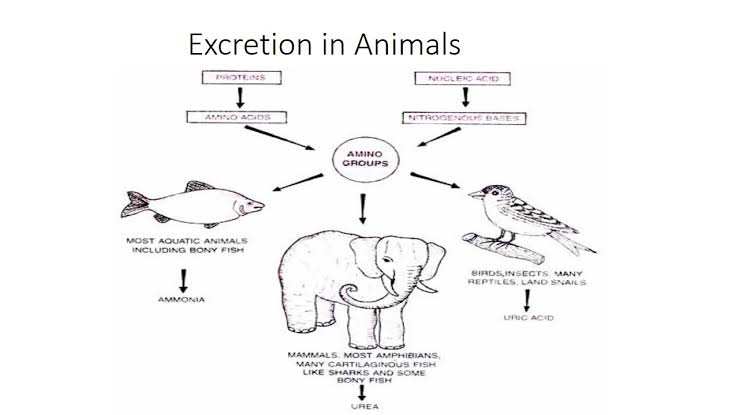
Excretion, the process by which animals rid themselves of waste products and of the nitrogenous by-products of metabolism. Through excretion organisms control osmotic pressure—the balance between inorganic ions and water—and maintain acid-base balance. The process thus promotes homeostasis, the constancy of the organism’s internal environment. Every organism, from the smallest protist to the largest mammal, must rid itself of the potentially harmful by-products of its own vital activities.
Transport of Substances in Plants
- Books Name
- CBSE Class 7 Science Book
- Publication
- Param Publication
- Course
- CBSE Class 7
- Subject
- Science
TRANSPORT OF SUBSTANCES IN PLANTS
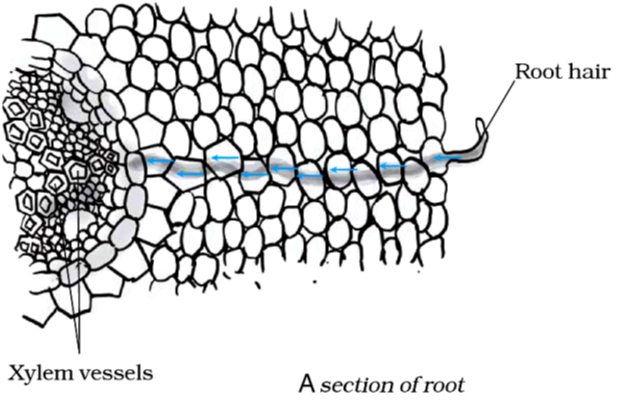
Plants absorb water and minerals from the soil through the roots. These are transported to the leaves for preparation of food (photosynthesis).
The food synthesized or prepared in the leaves is then carried to the other parts of the plant body. In plants therefore, transport involves two things :
(i) movement of water and minerals from the soil through the roots into the plant body and
(ii) movement of food prepared in the leaves to other plant parts.
Transport of Water and Minerals
• Plants absorb water and minerals through the roots. A large number of root hair are present on the roots. The root hair increase the surface area of the root for absorbing water and the minerals dissolved in water. The root hair absorb water present in between the soil particles. From the root hair, water along with the minerals enters the roots and from the roots, it moves upward towards the stem and leaves.
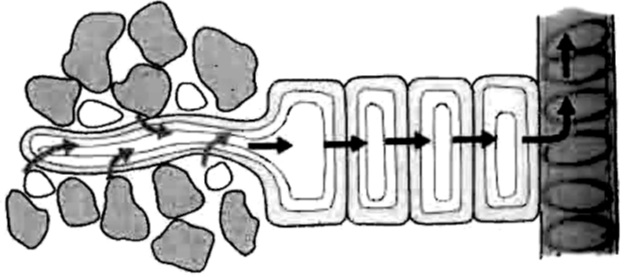
• The upward movement of water and minerals takes place through pipe-like structures or channels present throughout the plant body. These pipe-like structures or channels are made of special cells called xylem elements. Xylem is a vascular tissue for the transport of water and minerals in the plant.
• The xylem forms a continuous channel that connects roots to the leaves through the stem and branches. In this manner, water and minerals are carried to the entire plant.
Transport of Food
The food prepared in the leaves is transported to all parts of the plant. The vascular tissue that transports food is called phloem. Phloem is present along with the xylem inside the plant body. Xylem and phloem together form the vascular tissue.
TRANSPIRATION
The excess water is given out by the plants in vapour form to the atmosphere through their leaves. The process by which plants lose water in vapour form from their leaves is called transpiration.
Leaves contain tiny pores called stomata on their lower side. It is through these stomata that loss of water takes place by the process of transpiration.
Advantages of Transpiration
• It helps in the transport of water and minerals from the soil to the leaves.
• It produces a cooling effect, which protects the delicate cells from the hot sun.
• It provides rigidity to the plant body.
Circulatory System
Chapter 11: Transportation in Animals and Plants
Transportation in Animals and Plants. All the organisms need to transport water, food, minerals, oxygen to different parts of the body. They help in the growth and respiration of the cells. The waste products are transported to the excretory organs for elimination from the body.
Circulatory system
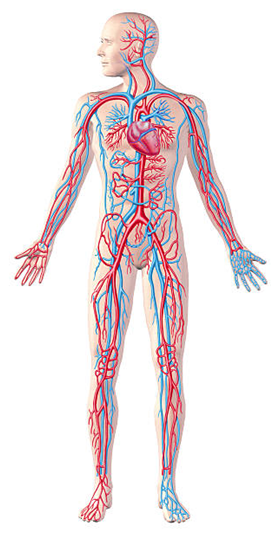
The blood circulatory system, is a system of organs that includes the heart, blood vessels, and blood which is circulated throughout the entire body of a human or other vertebrate. It includes the cardiovascular system, or vascular system, that consists of the heart and blood vessels (from Greek kardia meaning heart, and from Latin vascula meaning vessels). The circulatory system has two divisions, a systemic circulation or circuit, and a pulmonary circulation or circuit.[3] Some sources use the terms cardiovascular system and vascular system interchangeably with the circulatory system.
Transport of Substances in Plants
Transport of substance in plants
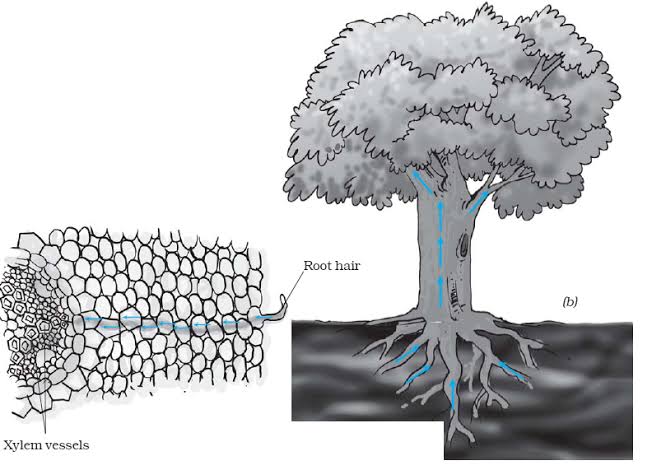
Plants have two transport systems – xylem and phloem. Xylem transports water and minerals. Phloem transports sugars and amino acids dissolved in water. The xylem transports water and minerals from the roots up the plant stem and into the leaves. In a mature flowering plant or tree, most of the cells that make up the xylem are specialised cells called vessels. Vessels: lose their end walls so the xylem forms a continuous, hollow tube. This allows water to flow easily.
Become strengthened by a chemical called lignin. The cells are no longer alive. Lignin gives strength and support to the vessel.

 Param Publication
Param Publication
 Grow Career Publication
Grow Career Publication
